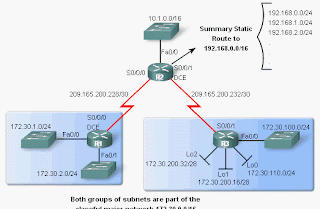
You should already be familiar with
RFC 1918 and the reasoning behind private addressing. All the examples in the curriculum use private IP addresses for the inside addressing example.
The RFC 1918-compliant addresses are shown in the table. But when IP traffic is routed across WAN links through an ISP, or when inside users need to access outside sites, a public IP address must be used.
 Cisco Example IP Addresses
Cisco Example IP AddressesYou may have noticed that the WAN links between R1, R2, and R3 are using public IP addresses. Although these IP addresses are not private addresses according to RFC 1918, Cisco has acquired some public address space to use for example purposes.
The addresses shown in the figure are all valid public IP addresses that are routable on the Internet. Cisco has set these addresses aside for educational purposes. Therefore, this course and future courses will use these addresses when there is a need to use public addresses.
In the figure, R1, R2, and R3 are connected using the 209.165.200.224/27 Cisco public address space. Because WAN links need only two addresses, 209.165.200.224/27 is subnetted with a /30 mask. In the topology, subnet 1 is assigned to the WAN link between R1 and R2. Subnet 2 is assigned to the WAN link between R2 and R3.







